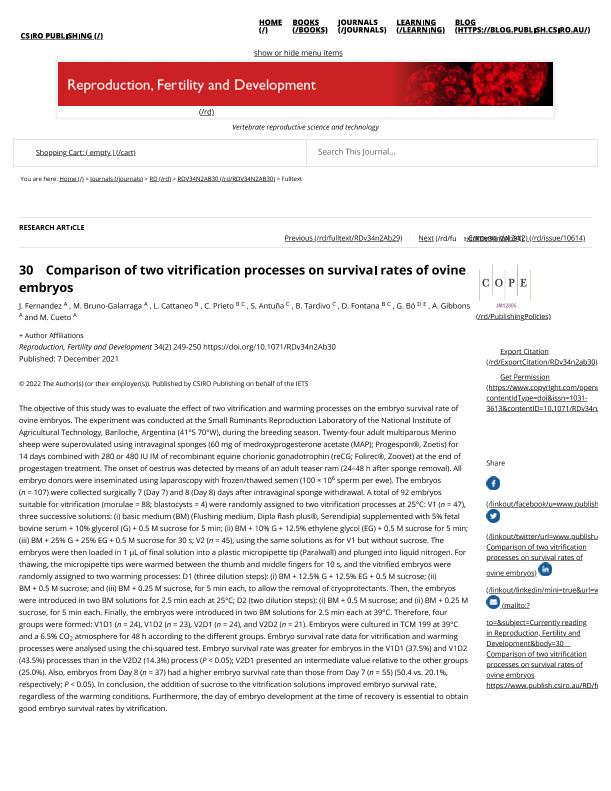Evento
Comparison of two vitrification processes on survival rates of ovine embryos
Fernandez, Jimena ; Bruno Galarraga, María Macarena
; Bruno Galarraga, María Macarena ; Cattaneo, Luciano; Prieto, Claudio
; Cattaneo, Luciano; Prieto, Claudio ; Antuña, Sebastián; Tardivo, Belén; Fontana, Diego Sebastian
; Antuña, Sebastián; Tardivo, Belén; Fontana, Diego Sebastian ; Bo, Gabriel; Gibbons, Alejandro Eduardo; Cueto, Marcela Isabel
; Bo, Gabriel; Gibbons, Alejandro Eduardo; Cueto, Marcela Isabel
 ; Bruno Galarraga, María Macarena
; Bruno Galarraga, María Macarena ; Cattaneo, Luciano; Prieto, Claudio
; Cattaneo, Luciano; Prieto, Claudio ; Antuña, Sebastián; Tardivo, Belén; Fontana, Diego Sebastian
; Antuña, Sebastián; Tardivo, Belén; Fontana, Diego Sebastian ; Bo, Gabriel; Gibbons, Alejandro Eduardo; Cueto, Marcela Isabel
; Bo, Gabriel; Gibbons, Alejandro Eduardo; Cueto, Marcela Isabel
Tipo del evento:
Conferencia
Nombre del evento:
48th Annual Conference International Embryo Technology Society
Fecha del evento:
10/01/2022
Institución Organizadora:
International Embryo Technology Society;
Título de la revista:
Reproduction Fertility and Development
Editorial:
Csiro Publishing
ISSN:
1031-3613
Idioma:
Inglés
Clasificación temática:
Resumen
The objective of this study was to evaluate the effect of two vitrification and warming processes on the embryo survival rate of ovine embryos. The experiment was conducted at the Small Ruminants Reproduction Laboratory of the National Institute of Agricultural Technology, Bariloche, Argentina (41°S 70°W), during the breeding season. Twenty-four adult multiparous Merino sheep were superovulated using intravaginal sponges (60 mg of medroxyprogesterone acetate (MAP); Progespon®, Zoetis) for 14 days combined with 280 or 480 IU IM of recombinant equine chorionic gonadotrophin (reCG; Folirec®, Zoovet) at the end of progestagen treatment. The onset of oestrus was detected by means of an adult teaser ram (24?48 h after sponge removal). All embryo donors were inseminated using laparoscopy with frozen/thawed semen (100 × 106 sperm per ewe). The embryos (n = 107) were collected surgically 7 (Day 7) and 8 (Day 8) days after intravaginal sponge withdrawal. A total of 92 embryos suitable for vitrification (morulae = 88; blastocysts = 4) were randomly assigned to two vitrification processes at 25°C: V1 (n = 47), three successive solutions: (i) basic medium (BM) (Flushing medium, Dipla flash plus®, Serendipia) supplemented with 5% fetal bovine serum + 10% glycerol (G) + 0.5 M sucrose for 5 min; (ii) BM + 10% G + 12.5% ethylene glycol (EG) + 0.5 M sucrose for 5 min; (iii) BM + 25% G + 25% EG + 0.5 M sucrose for 30 s; V2 (n = 45), using the same solutions as for V1 but without sucrose. The embryos were then loaded in 1 µL of final solution into a plastic micropipette tip (Paralwall) and plunged into liquid nitrogen. For thawing, the micropipette tips were warmed between the thumb and middle fingers for 10 s, and the vitrified embryos were randomly assigned to two warming processes: D1 (three dilution steps): (i) BM + 12.5% G + 12.5% EG + 0.5 M sucrose; (ii) BM + 0.5 M sucrose; and (iii) BM + 0.25 M sucrose, for 5 min each, to allow the removal of cryoprotectants. Then, the embryos were introduced in two BM solutions for 2.5 min each at 25°C; D2 (two dilution steps): (i) BM + 0.5 M sucrose; and (ii) BM + 0.25 M sucrose, for 5 min each. Finally, the embryos were introduced in two BM solutions for 2.5 min each at 39°C. Therefore, four groups were formed: V1D1 (n = 24), V1D2 (n = 23), V2D1 (n = 24), and V2D2 (n = 21). Embryos were cultured in TCM 199 at 39°C and a 6.5% CO2 atmosphere for 48 h according to the different groups. Embryo survival rate data for vitrification and warming processes were analysed using the chi-squared test. Embryo survival rate was greater for embryos in the V1D1 (37.5%) and V1D2 (43.5%) processes than in the V2D2 (14.3%) process (P < 0.05); V2D1 presented an intermediate value relative to the other groups (25.0%). Also, embryos from Day 8 (n = 37) had a higher embryo survival rate than those from Day 7 (n = 55) (50.4 vs. 20.1%, respectively; P < 0.05). In conclusion, the addition of sucrose to the vitrification solutions improved embryo survival rate, regardless of the warming conditions. Furthermore, the day of embryo development at the time of recovery is essential to obtain good embryo survival rates by vitrification.
Palabras clave:
VITRIFICATION
,
EMBRYO SURVIVAL
,
SUCROSE
,
SHEEP
Archivos asociados
Licencia
Identificadores
Colecciones
Eventos(CIVETAN)
Eventos de CENTRO DE INVESTIGACION VETERINARIA DE TANDIL
Eventos de CENTRO DE INVESTIGACION VETERINARIA DE TANDIL
Citación
Comparison of two vitrification processes on survival rates of ovine embryos; 48th Annual Conference International Embryo Technology Society; Savannah; Georgia; 2022; 249-250
Compartir
Altmétricas



